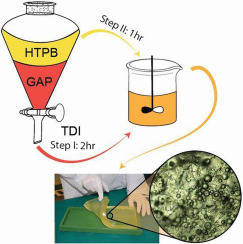Polymer ( IF 4.6 ) Pub Date : 2018-01-17 , DOI: 10.1016/j.polymer.2018.01.012 Levi Gottlieb , Hagit Greenfeld , Batya Blumer-Ganon

|
Low molecular weight Hydroxyl-Terminated-Polybutadiene (HTPB) and Glycidyl Azide Polymer (GAP) are completely immiscible. These pre-polymers were compatibilized by allowing the slow reacting GAP hydroxyls to react first with toluenediisocyanate (TDI) and only then adding HTPB with relatively fast reacting hydroxyls. The two stage procedure yielded a macroscopically homogenous rubber. The rubber is composed of cross-linked HTPB continuum scattered with 1–10 μm non-bonded GAP droplets. The droplet material was identified using Infra-Red (IR), Gel Permeation Chromatography (GPC) and Differential Scanning Calorimetry (DSC) analyses before and after extraction of the rubber. Dynamic Mechanical Analysis (DMA) was used for assessing the effect equivalent ratio ([NCO]/[OH]), composition (%GAP in the rubber) and reaction time (GAP/TDI 1st stage) have on the rubber properties. We have concluded that the large difference in the condensation rate of GAP hydroxyls versus HTPB hydroxyls with TDI (kHTPB/kGAP = [email protected] °C) is responsible for in situ formation of surface active species as GAP-b-(HTPB)n or GAP-g-(HTPB)n n ≥ 1, which enables compatibilization of the immiscible polymers. The formation of the postulated species is also supported by GPC analysis. This simple two step procedure eliminated the need to prepare a pre-made co-polymer or introduce appropriate functional groups on one or both component to achieve surface reaction and compatibilization.
中文翻译:

通过与二异氰酸酯的速率控制反应,使不混溶的液态羟基封端的聚合物对原位增容
低分子量的端羟基聚丁二烯(HTPB)和缩水甘油基叠氮化物聚合物(GAP)是完全不混溶的。通过使缓慢反应的GAP羟基首先与甲苯二异氰酸酯(TDI)反应,然后仅添加具有相对快速反应的羟基的HTPB,使这些预聚物相容。两步法制得宏观上均匀的橡胶。橡胶由散布有1–10μm非键合GAP小滴的交联HTPB连续体组成。在提取橡胶之前和之后,使用红外(IR),凝胶渗透色谱(GPC)和差示扫描量热法(DSC)分析来识别液滴材料。动态力学分析(DMA)用于评估效果当量比([NCO] / [OH]),组成(橡胶中的%GAP)和反应时间(GAP / TDI 1st stage)对橡胶性能有影响。我们得出的结论是,GDI羟基与HTPB羟基与TDI的缩合速率存在很大差异(kHTPB / K GAP = [电子邮件保护]℃)是在原位形成的表面活性物质的如GAP-B-负责(HTPB)ñ或GAP-G-(HTPB)ñ Ñ≥1,这使得不混溶的增容聚合物。GPC分析也支持了假定物种的形成。这种简单的两步程序消除了制备预制共聚物或在一种或两种组分上引入合适的官能团以实现表面反应和增容的需要。


























 京公网安备 11010802027423号
京公网安备 11010802027423号